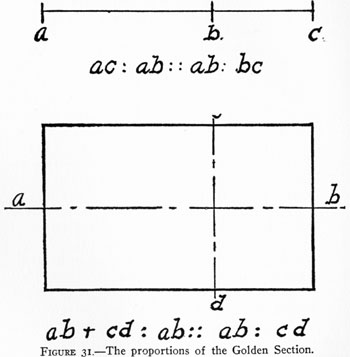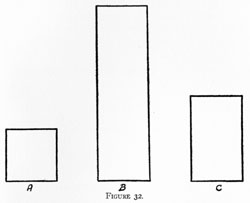Instrinsically Pleasing Proportions
Up to this point we have been concerned with proportion as expressive of significance and functional fitness, and with the adaptation of the various members of a decorative treatment to each other and to the whole. But the question very naturally suggests itself as to whether there may not be such a thing as intrinsically pleasing proportions, apart from any considerations of fitness or significance. May there not be some ideal ratio which we can accept as a norm by which to judge excellence or the lack of it in decorative composition?
This question was answered affirmatively by the artists of the Renaissance as the result of their study of proportion in classic art, and their conclusions were elaborated and set forth in the early part of the last century by Xeising in a treatise in which he urged as the ideal proportion what he called the Golden Section, or a division of any whole into two parts in such a way that the whole is to the larger part as the larger is to the smaller. Thus in the line ac, in Figure 31, ac : ab :: ab : bc, while in the rectangle the sum of the two diameters is to the longer diameter as the longer is to the shorter. Worked out arithmetically, this ratio is about that of five to three.
The golden section satisfies the requirements of the mind, and may be accepted as an approximate ideal. The basic fact with reference to excellence in proportion is that it is based upon the laws of repetition and principality. For example, the length and breadth of a rectangle, in order to satisfy the esthetic requirements of the mind, must be nearly enough alike so that their likeness is easily apparent; yet one dimension must be enough greater than the other to satisfy the need for a dominant element. Of the three rectangles shown in Figure 32, A, being square, satisfies the demand for likeness but not for principality; while B satisfies the demand for principality but not that for repetition. C alone satisfies both demands, and therefore it is alone accepted by the mind as of pleasing proportions. The ratio thus applied to the division of lines and the dimensions of rectangles was held by Xeising to be applicable to the dimensions of ellipses, rhombs and other geometrical forms, and in the arts of design to the proportions of floor and wall spaces, windows, doors, tables, rugs, books, vases, frames, chairs and chairbacks, and so on.

This ratio is pleasing because, as Raymond has pointed out, the mind judges of proportion by unconscious comparison of like spatial units, as it judges of rhythm in music and poetry by comparison of like accents. As long as these units are expressible in small ratios, like I :I or 1:2, they are easily perceptible. As the number of units is increased the ratio becomes more difficult to perceive and the proportion more subtle, up to the point where the mind is unable to judge the ratio. Thus the ratio 2:3 is more subtle and more interesting than the ratio I :I, yet it is easily sensed by the mind. On the other hand, ratios like 4:7, 7:12, or 9:14 involve a number of divisions beyond the power of the mind to grasp. Primitive art is very simple and involves endless repetition of the ratio 1:1, but as man's intelligence increases and his esthetic perceptions are developed his taste demands more subtle relationships. The proportion of 3 :5 satisfies the most highly trained eye and mind, as it satisfied the Greeks, because it is the most subtle that the mind can grasp with the ease necessary to esthetic enjoyment.

Long before the time of Xeising Vitruvius stated that the length of a room should be to its breadth as 5 :3, or as 3 :2; or, in the case of very large apartments, as 2:1. The decorator will find in practice that when a room varies widely from this ideal its apparent proportions must be altered through some of the devices noted above before the room can be made to seem satisfactory to a critical taste; and that, within the limits necessarily imposed by their function and particular situation, the various forms and surfaces in his treatment will be found to be increasingly pleasing to the mind as they approach the proportions of the golden section.
 "Finally! Step-by-Step Guidebooks Show
"Finally! Step-by-Step Guidebooks Show